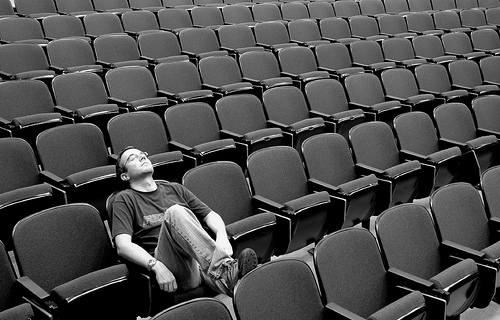Firstly let me introduce one of my colleagues – Sam. No he's not the guy in the picture, but a fellow blogger.... By reading across the blogs that I’ve provided links to at the top of my page you’ll get a good feel for the type and complexity of issues we tackle in improving the built environment in Scotland.
In Sam’s piece on measuring design there’s a critical element of measurement that’s missed – the fact that those doing the measurement, and selecting the scheme or the team, are human. Despite our best endeavours and the most rigorous and objective, even soulless, selection processes; at some point the client must choose the work of one human being over another and that choice is influenced by the confidence and comfort the client has in the team they select.
 Though seemingly against current conceptions of a fair process this element of measurement which we do subconsciously, and even unwillingly, can bring benefits. The most successful projects often happen where there’s a meeting of minds – a client and a designer who share a vision and can work skilfully together towards realising it. Clients often attribute the success the project to just such relationships “they knew how to really listen to us and understood what we wanted” . The soft skills to work through a project, to develop and maintain a constructive dialogue, are much prized by clients. However they’re not often an explicit part of the measurement they undertake.
Though seemingly against current conceptions of a fair process this element of measurement which we do subconsciously, and even unwillingly, can bring benefits. The most successful projects often happen where there’s a meeting of minds – a client and a designer who share a vision and can work skilfully together towards realising it. Clients often attribute the success the project to just such relationships “they knew how to really listen to us and understood what we wanted” . The soft skills to work through a project, to develop and maintain a constructive dialogue, are much prized by clients. However they’re not often an explicit part of the measurement they undertake.
From seeing a number of bidding processes from both sides over the past years two things have become clear to me.
- Client teams should make explicit how much they value ‘soft-skills’ in the selection process and rank them in relation to the design skills that are needed to translate an understanding of the client’s requirements into a successful or even a great outcome... “they not only delivered what we asked for, but also many things we didn’t know we hoped for”.
- Designers with the skills to deliver a great environment sometimes need to work on their communication skills. To come across as difficult is often to force clients to make up their mind between someone who may deliver a great building, but looks to be a pain to work with, and another team who listens attentively and reflects back to them their hopes and desires.
Given such a choice it’s hard for many clients – even if they can see a clear differentiation in the design potential on offer - to bite the bullet and take the higher hassle choice in the hope of a better outcome - they’re only human...
Ironically, a tool designed for measurement, AEDET (the NHS's toolkit for measuring design quality), has been shown to have a greater value in facilitating a constructive dialogue between client and designer. One of NHSScotland’s Design Champions, Dennis O’Keeffe of NHS Fife, showed in his recent research project that the true value of AEDET is in bringing people together to talk about what they need the building to do and how the design can realise that. This work-shopping contributed more to the quality of the outcome than using AEDET solely as a measurement tool.
Read more...









 At a previous project, ‘the Alex’ in Brighton, he brought together two groups – a children’s board and a group of what he calls his ‘young turks’ (clinicians who will go on to be senior staff members during the life of the new hospital) – to influence the development of the project and, in doing so, to form the basis of the culture and operation of the new service. Through this enthusiastic and honest engagement (which necessarily included frank discussions where ideas could not be realised) with these key groups the project achieved what many re-provisions struggle to – to transfer the affection and loyalty of the hospital community, and with them the broader public, from their previous magnificent, dilapidated and overstretched Victorian pile to a new home elsewhere in the city.
At a previous project, ‘the Alex’ in Brighton, he brought together two groups – a children’s board and a group of what he calls his ‘young turks’ (clinicians who will go on to be senior staff members during the life of the new hospital) – to influence the development of the project and, in doing so, to form the basis of the culture and operation of the new service. Through this enthusiastic and honest engagement (which necessarily included frank discussions where ideas could not be realised) with these key groups the project achieved what many re-provisions struggle to – to transfer the affection and loyalty of the hospital community, and with them the broader public, from their previous magnificent, dilapidated and overstretched Victorian pile to a new home elsewhere in the city.


